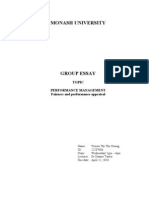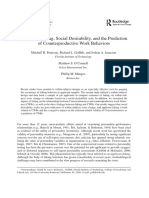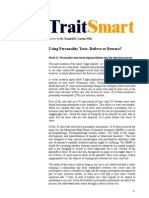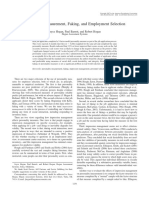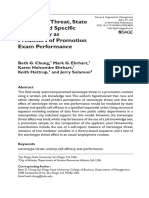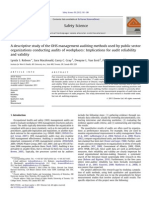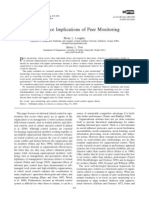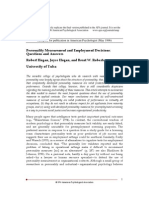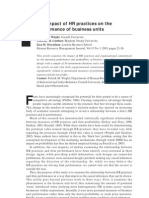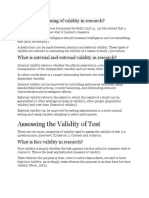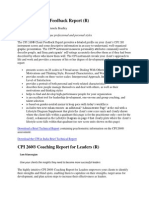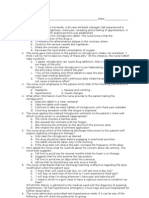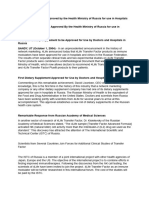Integry Testing
Integry Testing
Uploaded by
Vahmi Brian Owen D'sullivansevenfoldimerzCopyright:
Available Formats
Integry Testing
Integry Testing
Uploaded by
Vahmi Brian Owen D'sullivansevenfoldimerzOriginal Description:
Original Title
Copyright
Available Formats
Share this document
Did you find this document useful?
Is this content inappropriate?
Copyright:
Available Formats
Integry Testing
Integry Testing
Uploaded by
Vahmi Brian Owen D'sullivansevenfoldimerzCopyright:
Available Formats
http://www.iosolutions.org/Research_and_Re sources/Agency_Resources/White_Papers/Int egrity_Testing.
aspx 21 Okt 2013 Integrity Testing
Integrity testing as a pre-employment screen is cited by some (e.g., Berry, Sackett & Wiemann, 2007; Sackett, Burris & Callahan, 1989) as being an early attempt to detect dishonesty among applicants without having to resort to polygraph testing. Integrity testing quickly expanded and received even more attention when the Employee Polygraph Protection Act of 1988 (EPPA) restricted most employers from using polygraph testing as a selection tool; these paper-pencil tools were sought as means to usurp this law. Within the last two decades, integrity test use has continually grown to become one of the larger selection tool domains, and it is no longer viewed by experts as merely a legal polygraph proxy. In fact, integrity testing as shown to be one of the most valid and least impactful of selection tools currently available (Berry et al, 2007; Ones. Chockalingam, Viswesvaran & Schmidt, 1993; Sackett & Wanek, 1996; Schmidt & Hunter, 1998).
Current Models of Integrity
Two categories of integrity exams exist that have been proposed and are generally accepted by experts; those categories are overt integrity tests and personality-oriented tests (Sackett & Wanek, 1996). Overt tests conceptualize integrity tests in terms of direct questions regarding a test takers attitudes or past behaviors. Commonly, questions ask how often an individual has engaged in theft behaviors, drug usage behaviors, criminal behaviors or other wrongdoings. Additional questions directly inquire about beliefs on these same topic areas, such as punitiveness, endorsement of rationalizations for behaviors, and remorse for past actions (Berry, et al., 2007).
Personality-oriented exams are more covert as they assess personality constructs believed to be involved in integrity (e.g., socialization, positive outlook, orderliness/diligence). These tests may ask questions to assess individuals thrill-seeking behaviors, social conformity, attitudes towards authority, aggression, conscientiousness and dependability. Questions are phrased similar to those on personality exams; a test taker strongly agrees, agrees, is neutral, disagrees, or strongly disagrees to/with statements measuring a specific domain or construct (Berry, et al., 2007).
Integrity & Job-relevant Criteria
Integrity is an action, or behavior. As such, integrity measures should measure an individuals propensity to behave in certain ways. Both models, or categories, of integrity exams are developed to measure counterproductive workplace behaviors (CWB). These behaviors, if commonly performed by an individual, would suggest that a person lacks high levels of integrity. These behaviors vary, but some examples include the following: disciplinary problems, tardiness, absenteeism, turnover, violence, substance abuse, property damage, organizational rule breaking, and theft. All of these behaviors are harmful to organizations and agencies. They directly affect the achievement of individual job tasks and/or directly reduce an agencys bottom line. Thus, these behaviors are considered both by experts and the courts as job-relevant criteria; prediction of such behaviors constitutes a bona-fide business necessity (see Legal).
Counterproductive Workplace Behaviors
Generally, the research has found that both types of integrity exams (overt and personality-type) predict CWB equally well (Berry, et al., 2007). Research on Integritys prediction of CWB has generally shown moderate relationships. In a meta-analysis, Ones, et al., (1993) found that an overt test predicted a composite variable of CWBs consisting of disciplinary problems, tardiness, absenteeism, turnover, violence, substance abuse, property damage and organizational rule breaking, at =.39 (.27 uncorrected). Personality-oriented measures predicted CWBs slightly less, =.29 (.20 uncorrected).
Theft Behaviors
One counterproductive workplace behavior that is of special interest to many businesses and organizations is theft behaviors. The meta-analysis of Ones, et al., (1993) found a relationship between integrity exams and theft behaviors. Overt exams predicted external measure of actual theft and dismissal for theft, = .13 (.09 uncorrected). An even stronger relationship was found with overt integrity exams predicting admissions of theft and self-reports of dismissals for theft, = .33 (.30 uncorrected). It is important to note that the latter self-report value is likely to be the most accurate measure of the true validity in integrity exams predicting theft behaviors due to the fact that many thefts go unreported. This fact will tend to attenuate the true relationship; admission increases the reporting rate and thus will be a more accurate reflection of the integritytheft prediction.
Overall Job-Performance
Apart from predicting various CWBs, integrity exams are among the best predictors of overall job performance. Ones, et al. (1993) found a meta-analytic prediction of job performance by overt and personality-oriented integrity exams, = .41 (.23 uncorrected). Using this value, Schmidt and Hunter (1998) found that integrity exams add more incremental validity to cognitive ability in predicting job performance than any other personnel selection tool.
Combined they produce a large validity estimate ( = .65), suggesting that 42 percent of job performance variance is explained by this composite (an extremely large value for selection).
Faking on Integrity Tests
One issue relevant to integrity tests is the issue of candidate faking. This topic addresses the concern that individuals will be able to respond to questions in either socially desirable ways i.e., not respond to their personal beliefs or that individuals will not admit to actual behaviors in the overt portion of the exam. In either case, such response patterns could lead these individuals to have heightened or inflated exam scores. This is all the more troubling since such responding seems to be unethicalthe very quality the test aims to measure. Thus, individuals who should be screened out would instead receive inflated exam scores.
Research does suggest that faking is possible (Ellingson et al, 1999). However, the majority belief is that while people can fake when instructed to do so, individuals do not fake in real world situations (Hough et al., 1990; Morgeson et al., 2007; Ones & Viswesveran, 1998; Ones, Viswesveran & Reiss, 1996). This argument is supported by the fact that we are quite able to detect faking and socially desirable responses with various measures (Morgeson et al., 2007; Ones & Viswesveran, 1998); yet, such measures have no impact upon validity estimates. Thus, faking and measures of social desirability have virtually no impact upon measures of integrity (Hough et al., 1990; Morgeson et al., 2007; Ones & Viswesveran, 1998; Ones, Viswesveran & Reiss, 1996).
Adverse Impact
An important issue in all selection measures is that of adverse impact, and integrity is no exception. However, unlike other selection tools, integrity research is very promising in terms of its adverse impact on protected classes (for a description of this, see AI paper). Often the more valid tools (i.e., tools with the highest predictive relationship with on-the-job performance), such as cognitive ability measures, produce the highest adverse impact values. Integrity exams seem to be an exception to this trend. As the previous sections have indicated, integrity exams have very strong predictive relationships with criterion of interest, especially with performance. Still, research shows minimal to no difference in performance on integrity exams across protected groups, meaning that integrity exams do not adversely affect these protected groups (Ones, Viswesvaran, & Schmidt, 1996). Virtually the only sub-group differences appear between men and women, with women scoring .11 to .27 standard deviations higher than men; this will likely not violate the 4/5th rule of thumb (Ones, et al., 1996).
Integrity Exams in Public Safety Selection
Few integrity exams published have been developed or validated specifically for use in the public safety sector. I/O Solutions has researched and published on using integrity exams in the public safety sector. One study, Tawney (2008), found that agencies could use integrity exams as an early stage pre-employment selection tool as a means to mitigate failure rates in later, more expensive processes (e.g., polygraphs, background checks, and psychological evaluations). In total, a savings of up to 50 percent of the original cost of an entry-level selection process could be saved by using integrity exams (Tawney, 2009).
The exam used in Tawneys 2009 study was developed by I/O Solutions specifically for use in the public safety-specific setting. Research on this exam has shown that it is valid for use in this industry with high correlations (corrected for criteria unreliability) with business relevant criteria (Hard Drugs, Theft, Alcohol, and DUIs, r(192) = -.21, -.26, -.24, -.29), while showing no adverse impact against protected classes (Tawney, 2009).
References
Barry, C. M., Sackett, P. S., & Wiemann, S. (2007). A review of recent developments in integrity test research. Personnel Psychology, 60, 271-301.
Duehr,E. E., Sackett, P. R., & Ones, D. S. (2003). An examination of facet-level relationships between integrity and cognitive ability. Poster presented at the 18th Annual Conference of the Society for Industrial and Organizational Psychology, Orlandao, FL.
Ellingson, J. E., Sackett, P. R., & Hough, L. H. (1999). Social desirability corrections in personality measurement: Issues of applicant comparison and construct validity. Journal of applied psychology, 84, 155-166.
Hattrup, K., OConnell, M. S., & Labrador, J. R. (2005). Incremental validity of locus of control after controlling for cognitive ability and conscientiousness. Journal of Business and Psychology, Vol. 19, 461-471.
Hough, L. M., Eaton, N. K., Dunnette, M. D., Kamp, J. D., & McCloy, R. A. (1990). Criterionrelated validities of personality constructs and the effect of response distortion on those validities. Journal of Applied Psychology, 75, 581595.
Hough, L. M., & Schneider, R. J. (1996). Personality triats, taxonomies, and applications in organizations. In Murphy KR (ed.), Individual difference and behavior in organizations (pp. 3188). San Francisco: Jossey-Bass.
Morgeson, F. P., Campion, M. A., Dipboye, R. L., Hollenbeck, J. R., Murphy, K., & Schmitt, N. (2007). Personnel Psychology, 60, 683-729.
Ones D. S., Viswesvaran, C. (1998). The effects of social desirability and faking on personality and integrity assessment for personnel selection. Human Performance, 11, 245269.
Ones, D. S., Viswesvaran, C., & Reiss, A. D. (1996). Role of social desirability in personality testing for personnel selection: The red herring. Journal of Applied Psychology, 81, 660679.
Sackett, P. R., Burris, L. R., & Callahan, C. (1989). Integrity testing for personnel selection: An update. Personnel Psychology, 42, 491-529.
Tawney, M. W. (2009) Integrity Inventory Technical Report. Chicago, IL: I/O Solutions.
Wanek, J. E., Sackett, P. R., Ones, D. S. (2003). Towards an understanding of integrity test similarities and difference: An item-level analysis of seven tests. Personnel Psychology, 56, 873894.
You might also like
- Scalar Wave Laser Protocol ManualDocument40 pagesScalar Wave Laser Protocol ManualAnthony Usera100% (6)
- Lehmann and Crimando 2006 Veiled BarriersDocument12 pagesLehmann and Crimando 2006 Veiled BarriersIlana LehmannNo ratings yet
- 16PF Practitioner Report Interpretation TipsDocument2 pages16PF Practitioner Report Interpretation TipsVahmi Brian Owen D'sullivansevenfoldimerz0% (1)
- Evaluating a Psychometric Test as an Aid to SelectionFrom EverandEvaluating a Psychometric Test as an Aid to SelectionRating: 5 out of 5 stars5/5 (1)
- A Review of Recent Developments in Integrity Test Research: Personnel Psychology 2007, 60, 271-301Document31 pagesA Review of Recent Developments in Integrity Test Research: Personnel Psychology 2007, 60, 271-301Sanja DutinaNo ratings yet
- Ewnetu Et AlDocument43 pagesEwnetu Et AlewnetuNo ratings yet
- Fairness in HRMDocument10 pagesFairness in HRMTruyen Thi ThuNo ratings yet
- Validity and Reliability of A Pre-Employment Screening Test The Counterproductive Behavior Index (Cbi)Document21 pagesValidity and Reliability of A Pre-Employment Screening Test The Counterproductive Behavior Index (Cbi)Surya DhNo ratings yet
- Selection Procedure PDFDocument56 pagesSelection Procedure PDFAmit RobaNo ratings yet
- Applicant Faking, Social Desirability, and The Prediction of Counterproductive Work BehaviorsDocument22 pagesApplicant Faking, Social Desirability, and The Prediction of Counterproductive Work BehaviorsbarretdotcomNo ratings yet
- Legal MythsDocument4 pagesLegal MythsPersephona13No ratings yet
- Personality Measurement, Faking, and Employment Selection: Joyce Hogan, Paul Barrett, and Robert HoganDocument16 pagesPersonality Measurement, Faking, and Employment Selection: Joyce Hogan, Paul Barrett, and Robert HoganDingoDrongoNo ratings yet
- Chung 2009Document31 pagesChung 2009Gaurav YadavNo ratings yet
- Safety Science: Lynda S. Robson, Sara Macdonald, Garry C. Gray, Dwayne L. Van Eerd, Philip L. BigelowDocument9 pagesSafety Science: Lynda S. Robson, Sara Macdonald, Garry C. Gray, Dwayne L. Van Eerd, Philip L. Bigelowphoenixz100No ratings yet
- Audit DiscriminationDocument30 pagesAudit DiscriminationnachersNo ratings yet
- Iliescu Et Al (2012, IJSA) - EI in Personnel Selection PDFDocument12 pagesIliescu Et Al (2012, IJSA) - EI in Personnel Selection PDFDiana BanciuNo ratings yet
- Performance Implications of Peer Monitoring: ScienceDocument15 pagesPerformance Implications of Peer Monitoring: ScienceNg Chi KeungNo ratings yet
- Personality Measurement and Employment DecisionsDocument21 pagesPersonality Measurement and Employment DecisionsJosiah KingNo ratings yet
- Notions of Reliability: EPSY 5244 1Document4 pagesNotions of Reliability: EPSY 5244 1bongit333No ratings yet
- The Impact of Applicant FakingDocument16 pagesThe Impact of Applicant FakingCata BernaboNo ratings yet
- Emotional IntelligenceDocument13 pagesEmotional Intelligencedanamaria13No ratings yet
- A Critical Review and Best-Practice Recommendations For Control Variable UsageDocument55 pagesA Critical Review and Best-Practice Recommendations For Control Variable UsageDiego Flores LopezNo ratings yet
- Characteristics of SEM: Cov R SD SDDocument9 pagesCharacteristics of SEM: Cov R SD SDHans JonniNo ratings yet
- Nikolaou2007-Personal SelectDocument14 pagesNikolaou2007-Personal SelectKhánh LâmNo ratings yet
- RDQM Ass1Document7 pagesRDQM Ass1Natasha ModibaNo ratings yet
- The Effects On Job Attitude of Perception of Justice in The HRM SystemDocument17 pagesThe Effects On Job Attitude of Perception of Justice in The HRM SystemSangha ToyNo ratings yet
- Chapter - IDocument50 pagesChapter - IHoney HameedNo ratings yet
- SfoidglsfldsgDocument6 pagesSfoidglsfldsgGulzar AliNo ratings yet
- Essay Validity and Reliability Selection MethodsDocument15 pagesEssay Validity and Reliability Selection MethodsCosmin OuatuNo ratings yet
- Propensity Scores: A Practical Introduction Using RDocument21 pagesPropensity Scores: A Practical Introduction Using RMunirul UlaNo ratings yet
- Deselection Reasons: Guide To Choosing Deselection Reasons in Talent Acquisition Manager (TAM)Document8 pagesDeselection Reasons: Guide To Choosing Deselection Reasons in Talent Acquisition Manager (TAM)arshan1992No ratings yet
- Cawley Keeping Levy 1998Document19 pagesCawley Keeping Levy 1998Nguyen Hoang Minh QuocNo ratings yet
- The Effect of Corporate Social Responsibility On Employee Counterproductive BehaviourDocument8 pagesThe Effect of Corporate Social Responsibility On Employee Counterproductive BehaviourKu Yoon LianNo ratings yet
- Legal, I-O, and Clinical WORKDocument9 pagesLegal, I-O, and Clinical WORKNavneet DhimanNo ratings yet
- Del Missier, F., Mäntylä, T. y Bruine de Bruin, W. (2010) - Executive Fuctions in Decision Making An Individual Differences Approach.Document29 pagesDel Missier, F., Mäntylä, T. y Bruine de Bruin, W. (2010) - Executive Fuctions in Decision Making An Individual Differences Approach.Fernando Ángel Villalva-SánchezNo ratings yet
- (Un) Ethical Behavior and Performance AppraisalDocument14 pages(Un) Ethical Behavior and Performance AppraisalDaniele BerndNo ratings yet
- Regression Analysis: Reliability and ValidityDocument4 pagesRegression Analysis: Reliability and Validityjayaprakash dasNo ratings yet
- The Performance Versus Ability Distinction Following Social Comparison FeedbackDocument9 pagesThe Performance Versus Ability Distinction Following Social Comparison FeedbackMadalina RobuNo ratings yet
- Fa Screening ToolDocument14 pagesFa Screening Toolsandeep1640No ratings yet
- The Objective Assessment of Personality. An Alternative To Self-Report Based AssessmentDocument16 pagesThe Objective Assessment of Personality. An Alternative To Self-Report Based AssessmentDoni Dhawa FaithfullNo ratings yet
- Personality TestDocument5 pagesPersonality TestJananthan ThavarajahNo ratings yet
- (Reuning & Plutzer, 2020) Valid Vs Invalid Straighlining The Complex Relationship Between Straighlining and Data QualityDocument21 pages(Reuning & Plutzer, 2020) Valid Vs Invalid Straighlining The Complex Relationship Between Straighlining and Data QualitySoha ConsultantsNo ratings yet
- BobrowDocument3 pagesBobrowJUAN DAVID URIBE GONZALEZNo ratings yet
- Running Head: Ethical, Social, and Legal Issues 1Document5 pagesRunning Head: Ethical, Social, and Legal Issues 1Sanghamitra DanNo ratings yet
- Influence of Interactional Justice On The Turnover Behavioral Decision in AnDocument12 pagesInfluence of Interactional Justice On The Turnover Behavioral Decision in AnVeinne NathasiaNo ratings yet
- What To Look For in A Psychological TestDocument32 pagesWhat To Look For in A Psychological TestKella OrtegaNo ratings yet
- Discussion Piece: The Psychometric Principles of Assessment Professor John Rust Psychometrics CentreDocument5 pagesDiscussion Piece: The Psychometric Principles of Assessment Professor John Rust Psychometrics CentreyahoobijakNo ratings yet
- The Attribution of Service FailureDocument16 pagesThe Attribution of Service FailureSylvester BooNo ratings yet
- Hrm&a Group AssignmentDocument8 pagesHrm&a Group AssignmentDivya ParmarNo ratings yet
- The Impact of HR Practices On The Performance of Business UnitsDocument16 pagesThe Impact of HR Practices On The Performance of Business UnitsMaria AhmedNo ratings yet
- Gender and Ethical Orientation: A Test of Gender and Occupational Socialization TheoriesDocument6 pagesGender and Ethical Orientation: A Test of Gender and Occupational Socialization TheoriesMaria De Jesus BezerraNo ratings yet
- The Use of Personality Measures in Personnel Selection: What Does Current Research Support?Document26 pagesThe Use of Personality Measures in Personnel Selection: What Does Current Research Support?Oana SmeureanuNo ratings yet
- Validity and ReliabilityDocument6 pagesValidity and ReliabilityfarlynzNo ratings yet
- A Comparison of Empirically Based and Structured Professional Judgment Estimation of Risk Using The Structured Assessment of Violence Risk in YouthDocument18 pagesA Comparison of Empirically Based and Structured Professional Judgment Estimation of Risk Using The Structured Assessment of Violence Risk in YouthDark SiriusNo ratings yet
- Behavioral Observation Scales For Performance Appraisal PurposesDocument14 pagesBehavioral Observation Scales For Performance Appraisal PurposesSalman Ahmad KahloonNo ratings yet
- The Leadership Quarterly: Rachel E. Frieder, Wayne A. Hochwarter, Philip S. DeortentiisDocument17 pagesThe Leadership Quarterly: Rachel E. Frieder, Wayne A. Hochwarter, Philip S. DeortentiisHafizh RachmanNo ratings yet
- Messick, 1980Document16 pagesMessick, 1980PaolaNo ratings yet
- Assessing The Validity of TestDocument4 pagesAssessing The Validity of TestAnanya NarangNo ratings yet
- Research Proposal Allison HarlanDocument5 pagesResearch Proposal Allison Harlanapi-749525004No ratings yet
- Erceived Fairness of Disciplinary Procedures in The Public Service Sector An Exploratory StudyDocument8 pagesErceived Fairness of Disciplinary Procedures in The Public Service Sector An Exploratory StudydipusdianpusNo ratings yet
- Admin,+7205 ArtclDocument13 pagesAdmin,+7205 Artclemmahurst2004No ratings yet
- The Performance of Performance AppraisalDocument21 pagesThe Performance of Performance AppraisalsabrinajoeykingNo ratings yet
- Rating Guides: 2 Point ScalesDocument2 pagesRating Guides: 2 Point ScalesVahmi Brian Owen D'sullivansevenfoldimerzNo ratings yet
- Understanding The Personality Test IndustryDocument3 pagesUnderstanding The Personality Test IndustryVahmi Brian Owen D'sullivansevenfoldimerzNo ratings yet
- George Baker SelectionDocument9 pagesGeorge Baker SelectionVahmi Brian Owen D'sullivansevenfoldimerzNo ratings yet
- PUKULDocument1 pagePUKULVahmi Brian Owen D'sullivansevenfoldimerzNo ratings yet
- Workplace Personality Assess Cturner2Document13 pagesWorkplace Personality Assess Cturner2Vahmi Brian Owen D'sullivansevenfoldimerz100% (1)
- 2012 Bersin Global Leadership Developing Tomorrows LeadersDocument42 pages2012 Bersin Global Leadership Developing Tomorrows LeadersVahmi Brian Owen D'sullivansevenfoldimerzNo ratings yet
- Change and Innovation Assessment1Document3 pagesChange and Innovation Assessment1Vahmi Brian Owen D'sullivansevenfoldimerzNo ratings yet
- Spiritual GiftsDocument10 pagesSpiritual GiftsVahmi Brian Owen D'sullivansevenfoldimerzNo ratings yet
- 16PF Competency Report Interpretation TipsDocument1 page16PF Competency Report Interpretation TipsVahmi Brian Owen D'sullivansevenfoldimerzNo ratings yet
- Cpi 260Document2 pagesCpi 260Vahmi Brian Owen D'sullivansevenfoldimerzNo ratings yet
- The Changing Paradigm of Management & Foundations of Learning OrganizationsDocument21 pagesThe Changing Paradigm of Management & Foundations of Learning OrganizationsVahmi Brian Owen D'sullivansevenfoldimerzNo ratings yet
- Understanding Management: First Canadian EditionDocument22 pagesUnderstanding Management: First Canadian EditionVahmi Brian Owen D'sullivansevenfoldimerzNo ratings yet
- Understanding Management: First Canadian EditionDocument23 pagesUnderstanding Management: First Canadian EditionVahmi Brian Owen D'sullivansevenfoldimerzNo ratings yet
- Understanding Management: First Canadian EditionDocument21 pagesUnderstanding Management: First Canadian EditionVahmi Brian Owen D'sullivansevenfoldimerzNo ratings yet
- Understanding Management: First Canadian EditionDocument21 pagesUnderstanding Management: First Canadian EditionVahmi Brian Owen D'sullivansevenfoldimerzNo ratings yet
- Understanding Management: First Canadian EditionDocument23 pagesUnderstanding Management: First Canadian EditionVahmi Brian Owen D'sullivansevenfoldimerzNo ratings yet
- Understanding Management: First Canadian EditionDocument18 pagesUnderstanding Management: First Canadian EditionVahmi Brian Owen D'sullivansevenfoldimerzNo ratings yet
- Academic Motivation ScaleDocument21 pagesAcademic Motivation ScaleSenoro Steven67% (3)
- Confederation of Indian Industry: Pharmaceutical ProductsDocument27 pagesConfederation of Indian Industry: Pharmaceutical ProductsManjunath N SNo ratings yet
- 7 - Machine Safety PDFDocument19 pages7 - Machine Safety PDFJohn Paulo Tacud100% (1)
- Assessing EarsDocument11 pagesAssessing EarsRhea Mae Visda RoaNo ratings yet
- Pharmacological Nursing NotesDocument7 pagesPharmacological Nursing NotesFreeNursingNotes33% (3)
- Questionnaire 2Document1 pageQuestionnaire 2Anonymous fvY2BzPQVx89% (9)
- Female Reproductive OrgansDocument32 pagesFemale Reproductive Organsapi-19916399100% (1)
- DocumentDocument8 pagesDocumentWorld ChangerNo ratings yet
- Disadvantages of Artificial IntelligenceDocument3 pagesDisadvantages of Artificial Intelligenceharshal9891No ratings yet
- 12 Basic Exercises Molly Galbraith PDFDocument22 pages12 Basic Exercises Molly Galbraith PDFOkanNo ratings yet
- Adoption, Family Ideology, and Social StigmaDocument8 pagesAdoption, Family Ideology, and Social StigmaAbdi ChimdoNo ratings yet
- High Frequency Economic IndicatorsDocument3 pagesHigh Frequency Economic IndicatorsDarshan YadunathNo ratings yet
- Silicon N-Channel Power F-MOS FETDocument2 pagesSilicon N-Channel Power F-MOS FETboled_2No ratings yet
- Design of Green Building: A Case Study For Composite ClimateDocument6 pagesDesign of Green Building: A Case Study For Composite ClimatesushmakNo ratings yet
- Carnivore75Hard Community Cookbook Carnivore Cure BonusDocument45 pagesCarnivore75Hard Community Cookbook Carnivore Cure BonusSilvana HekierNo ratings yet
- Charles Chaplin: Academia Marratxí Carrer Casa Del Poble 9 Teléfono: 971.781.286Document2 pagesCharles Chaplin: Academia Marratxí Carrer Casa Del Poble 9 Teléfono: 971.781.286Derly CeRo100% (1)
- Types of MealDocument43 pagesTypes of MealRajrshi DubeyNo ratings yet
- Redpost Pasteurization Monitor Rpu Haffmans Leaflet v2102 enDocument2 pagesRedpost Pasteurization Monitor Rpu Haffmans Leaflet v2102 enFilipe FerreiraNo ratings yet
- Os-Wtr Dams-Published Papers FinalDocument2 pagesOs-Wtr Dams-Published Papers FinalAnonymous T02GVGzBNo ratings yet
- DS14C232J/B: Low Power Line TransceiverDocument1 pageDS14C232J/B: Low Power Line TransceiverSaikumarNo ratings yet
- Dipole MomentsDocument16 pagesDipole MomentsVina Kristi DiscarNo ratings yet
- Rockefeller Annual ReportDocument66 pagesRockefeller Annual ReportIrvan GarutNo ratings yet
- GCP Training ManualDocument34 pagesGCP Training ManualpatibautistaNo ratings yet
- Lecture 1 - AccessibleDocument54 pagesLecture 1 - AccessibleBirdsflyingontheskyNo ratings yet
- Sword Art Online - Volume 04 - Fairy Dance (Yen Press) (Kobo - Kitzoku)Document253 pagesSword Art Online - Volume 04 - Fairy Dance (Yen Press) (Kobo - Kitzoku)random userNo ratings yet
- Enhancement On Coffee Processing Facility (Roasting Machine)Document16 pagesEnhancement On Coffee Processing Facility (Roasting Machine)Ruby Faith EspinosaNo ratings yet
- Test Bank For Caring For Older Adults Holistically 5th Edition, MaryDocument28 pagesTest Bank For Caring For Older Adults Holistically 5th Edition, MaryILL108100% (1)
- Bill of Lading Form - Printable TemplateDocument1 pageBill of Lading Form - Printable TemplateFlorencia B. QuiñonesNo ratings yet
- Surajpura Water Supply BrochureDocument2 pagesSurajpura Water Supply Brochuresushil kumarNo ratings yet






